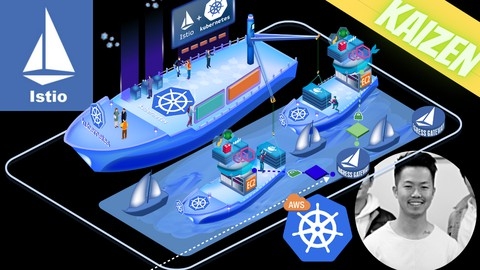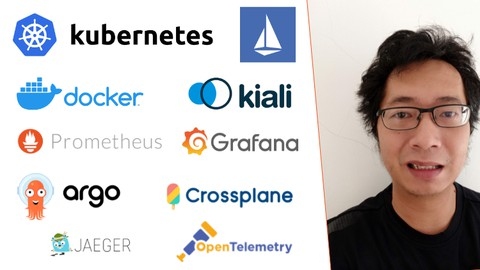Istio is a powerful service mesh that brings a wealth of capabilities to your Kubernetes deployments.
It allows you to manage and secure microservices, control traffic flow, enhance observability, and improve the overall resilience of your applications.
Learning Istio is crucial for anyone working with microservices on Kubernetes, as it empowers you to build robust, scalable, and secure applications in a modern cloud-native environment.
By mastering Istio, you can unlock advanced features like traffic management, security policies, and observability tools, significantly improving the performance and reliability of your applications.
Finding a top-notch Istio course on Udemy can be challenging, with numerous options vying for your attention.
You’re seeking a course that not only covers the fundamentals but also dives into practical applications and real-world scenarios.
You want an engaging learning experience that equips you with the skills and confidence to effectively leverage Istio in your projects.
We’ve meticulously reviewed a plethora of Istio courses on Udemy and found that the Istio Hands-On for Kubernetes course stands out as the best overall.
This course provides a comprehensive and practical approach to learning Istio, guiding you through hands-on exercises and real-world examples.
You’ll gain a deep understanding of Istio’s architecture, core components, and advanced features, enabling you to confidently deploy, manage, and secure your microservices using Istio.
However, the learning journey doesn’t stop here.
We have curated a selection of other exceptional Istio courses on Udemy, catering to different learning styles and focusing on specific aspects of this powerful service mesh.
Read on to discover the perfect Istio course to propel your Kubernetes expertise to new heights.
Istio Hands-On for Kubernetes
This Istio Hands-On for Kubernetes course equips you with the knowledge and skills to effectively manage and secure microservices on Kubernetes using Istio.
You begin by establishing your local Kubernetes environment using Docker Desktop or Minikube, guided by clear instructions.
The course then introduces you to Istio, its architecture, and its core components like Envoy, the data plane proxy.
You quickly delve into hands-on exercises, using real-world examples to grasp key concepts.
You explore traffic management techniques, including canary deployments and dark releases, using tools like VirtualService and DestinationRule for sophisticated routing.
The course emphasizes security, teaching you how to implement mutual TLS (mTLS) to encrypt communication within your cluster.
You gain experience using Kiali to visualize your system’s behavior and Jaeger for distributed tracing, enabling efficient monitoring and troubleshooting.
The course doesn’t shy away from advanced topics.
You learn about fault injection, circuit breaking, and outlier detection, enhancing the resilience of your microservices.
You discover how to customize and manage your Istio installation using Istioctl, explore different Istio profiles, and master upgrading Istio using various techniques like rolling upgrades and live cluster switchovers.
You finish the course with the confidence to deploy, manage, and secure your microservices using Istio.
Complete Istio Service Mesh (1.8) Masterclass + AWS EKS
This course on Istio Service Mesh, specifically version 1.8, paired with Amazon’s Elastic Kubernetes Service (EKS), equips you with the skills to manage and secure microservices in a cloud-native environment.
You begin by understanding the core concepts of a service mesh and the advantages of using Istio.
The course then guides you through setting up your own AWS environment, creating an EKS cluster, and deploying Istio.
You then explore the crucial aspect of traffic management, learning how to use Istio’s features to control the flow of requests between your services.
Imagine being able to gradually roll out updates to a small portion of users with canary deployments.
You’ll master techniques like weighted routing to distribute traffic, fault injection to test the resilience of your applications, and how to set up timeouts and retries.
You learn to use tools like Virtual Services and Destination Rules to implement these traffic management strategies.
The course doesn’t neglect security.
You discover how to configure TLS/HTTPS to encrypt communication between your services and enable mutual TLS for enhanced security.
You’ll learn about end-user authentication and authorization using JSON Web Tokens (JWT).
This ensures that only authorized users can access your applications.
Additionally, you gain experience with observability tools like Jaeger and Kiali.
These tools empower you to monitor requests, visualize traffic flow, and troubleshoot issues within your applications.
You’ll become comfortable using Grafana and Prometheus to keep a close eye on the health and performance of your service mesh.
Practical Devops : Kubernetes & Istio with Google Cloud
This course takes you on a journey from the basics of containerization with Docker to the intricate world of Kubernetes and Istio.
You’ll begin by building Docker images and understanding semantic versioning, essential skills for managing your application’s building blocks.
Then, you’ll dive into Kubernetes, learning how to deploy and manage applications using Pods, Deployments, and Services.
You will master how to configure your applications using ConfigMaps and Secrets while securing them using Service Accounts, Resource Quotas, and Namespaces.
You will then explore advanced Kubernetes concepts, such as using Helm to package and deploy your applications and ArgoCD to implement GitOps, a modern approach to infrastructure management.
The course then introduces you to Istio, where you learn to manage traffic flow between your microservices using techniques like Canary Releases and Dark Launching.
You’ll explore the power of fault injection, simulating failures to test the resilience of your applications.
You’ll also learn how to leverage Istio’s capabilities to secure your East-West traffic using Mutual TLS, ensuring secure communication between your services.
Throughout the course, you’ll work with powerful tools like Prometheus, Grafana, Jaeger, and Kiali, giving you the ability to monitor your applications, visualize your service mesh, and trace requests across your system.
You will discover how to manage your cloud infrastructure from Kubernetes and optimize your deployments using techniques like Node Affinity and Pod Topology Spread.
Building real-world Multitenant application
If you want to become an expert in building multi-tenant applications, this course is a great place to start.
The course begins with the fundamentals of virtualization and containerization.
You will learn how to set up a virtual machine using VirtualBox and Ubuntu, and then dive into Docker, where you will master important commands for building, running, and managing containers.
You will also explore tools like Docker Compose and Docker Swarm for managing multi-container applications.
You will then move on to automation with Ansible.
You will learn how to use Ansible to configure systems, deploy applications, and manage your infrastructure.
This part of the course will give you hands-on experience with Ansible, including how to troubleshoot common issues.
With a solid understanding of Docker and Ansible, you will then dive into the world of Kubernetes.
You will learn how to install and configure Minikube, a local Kubernetes environment, and explore essential Kubernetes concepts like Pods, Deployments, Services, and Ingress.
You will also learn how to secure your Kubernetes cluster using RBAC and manage resources like ConfigMaps, Secrets, and storage.
You will even learn about advanced Kubernetes concepts like Request & Limits, LimitRange, ResourceQuota, and Quality of Service (QoS) class.
The course then takes you deeper into Kubernetes by introducing the Operator SDK.
This framework allows you to build your own custom Kubernetes Operators, which automate complex application management tasks.
Through hands-on labs, you will gain practical experience building a multi-tenant portal application using the Operator SDK.
Finally, you will learn how to integrate Istio, a powerful service mesh, into your multi-tenant application.
You will explore Istio’s architecture, learn about its key components like VirtualService, DestinationRule, and Gateway, and understand how to use Istio to manage traffic, security, and observability for your microservices.
The course culminates with a real-world project where you will apply everything you have learned to build a multi-tenant application using Kubernetes, Docker, Ansible, and Istio.




